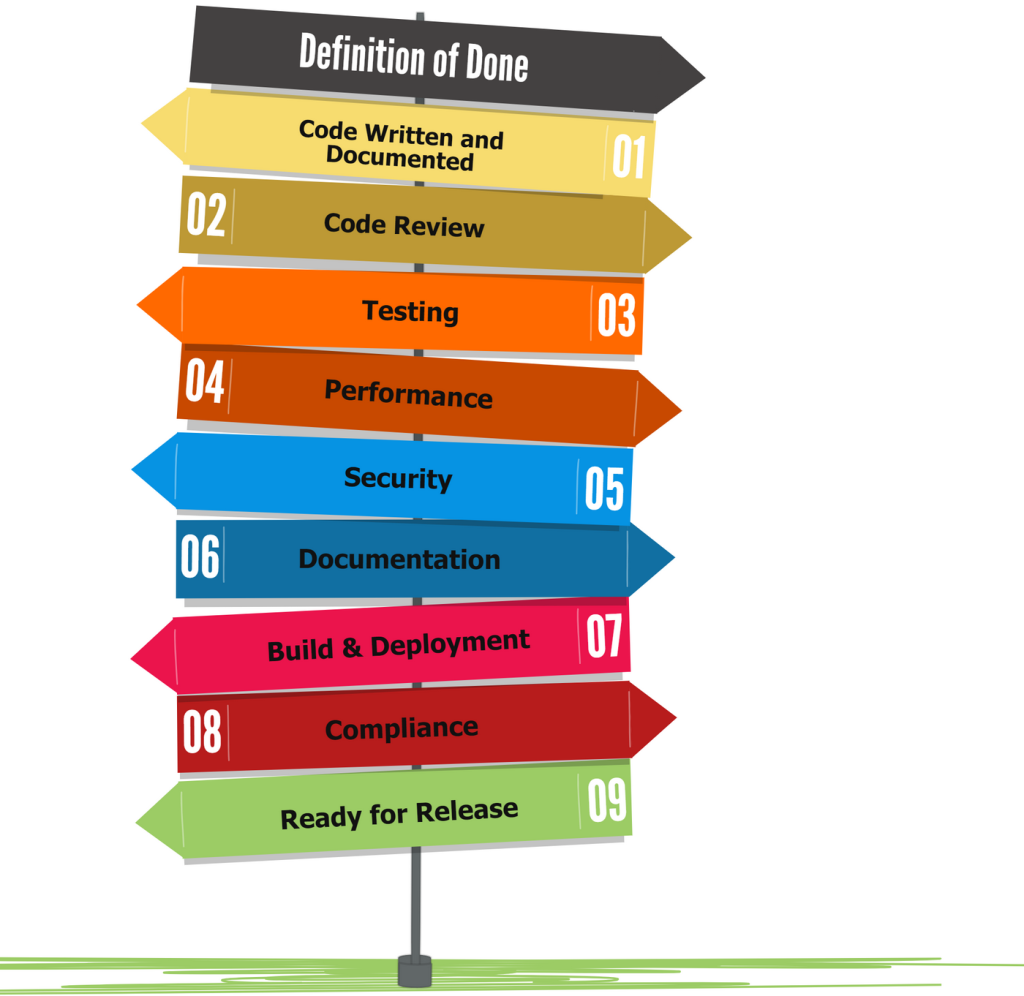Embarking on the Journey: The Critical Role of DoD in Agile Projects
With its rapid developments and impressive results, Navigating the world of Agile demands one essential element for success: clear definitions. That’s where the Definition of Done (DoD) comes into play.
Imagine a scenario: a team is tasked with building a car. The specifications are clear, but what does ‘done’ really mean?
For the engineer, ‘done’ might mean the engine runs smoothly. For the designer, it’s about the final polish and aesthetics. For the quality inspector, ‘done’ is not reached until every safety test is passed with flying colors.
Here lies the essence of the DoD dilemma – without a universally accepted definition of ‘done,’ the car might leave the production line with a roaring engine and a stunning design but lacking critical safety features.
In Agile projects, this is a common pitfall. Teams often have varied interpretations of completion, leading to inconsistent and sometimes incomplete results.
A meticulously constructed DoD serves as the critical point of convergence for different team viewpoints, guaranteeing that a task is only considered ‘done’ when it fully satisfies every requirement – encompassing its functionality and aesthetic appeal, safety standards, and overall quality.
Let’s explore how the DoD transforms Agile projects from a collection of individual efforts into a cohesive, high-quality masterpiece.
From Chaos to Clarity: A Real-World Story of Transformation
Let me take you back to a time in my career that perfectly encapsulates the chaos resulting from a lack of a universally understood DoD. In a former company, our project landscape resembled a bustling bazaar – vibrant but chaotic.
Both internal and external teams were diligently working on a complex product, each with their own understanding of ‘completion.’
The first sign of trouble was subtle – code contributions from different teams that didn’t fit together smoothly. A feature ‘completed’ by one team would often break the functionality of another. The build failures became frequent, and the debugging sessions became prolonged detective hunts, frequently ending in finger-pointing.
I recall one incident vividly. A feature was marked ‘done’ and passed on for integration. It looked polished on the surface – the code was clean and functioned as intended. However, during integration testing, it failed spectacularly.
The reason? It wasn’t compatible with the existing system architecture. The team that developed it had a different interpretation of ‘done.’ For them, ‘done’ meant working in isolation, not as a part of the larger system. Hence, we had to rework everything, throwing away weeks of work.
This experience was our wake-up call. It made us realize that without a shared, clear, and comprehensive DoD, we were essentially rowing in different directions, hoping to reach the same destination. It wasn’t just about completing tasks but about integrating them into a cohesive, functioning whole.
This realization was the first step towards our transformation – from chaos to clarity.
Unveiling the DoD: Components of a Robust Agile Framework
After witnessing firsthand the chaos that ensues without a clear DoD, let’s unpack what a robust Definition of Done should encompass in an Agile project.
But let’s start with a definition.
What is a Definition of Done (DoD)?
The Definition of Done (DoD) is an agreed-upon set of criteria in Agile and software development that specifies what it means for a task, user story, or project feature to be considered complete.
The development team and other relevant stakeholders, such as product owners and quality assurance professionals, collaboratively establish this definition.
The DoD typically encompasses various deliverable aspects, including coding, testing (unit, integration, system, and user acceptance tests), documentation, and adherence to coding standards and best practices.
By clearly defining what “done” means, the DoD provides a clear benchmark for completion, ensuring that everyone involved in the development process has a shared understanding of what is expected for a deliverable to be considered finished.
Now we know what a DoD is. But I’d like to elaborate once more on why it is needed:
Why is the Definition of Done Necessary?
The DoD is essential for several reasons.
Firstly, it ensures consistency and quality across the product development lifecycle. By having a standardized set of criteria, the development team can uniformly assess the completion of tasks, thus maintaining a high-quality standard across the project.
Secondly, it facilitates better collaboration and communication between the teams and with stakeholders. When everyone agrees on what “done” means, it reduces ambiguities and misunderstandings, leading to more efficient and effective collaboration.
Thirdly, the DoD helps in effective project tracking and management. It provides a clear framework for assessing progress and identifying any gaps or areas needing additional attention.
Finally, it contributes to customer satisfaction; a well-defined DoD ensures that the final product meets the client’s expectations and requirements, as every aspect of the product development has been rigorously checked and validated against the agreed-upon criteria.
Right, but what does such a DoD look like?
Understanding the key components of a Definition of Done (DoD) is crucial for a successful Agile project. Here are some typical elements that can be included in a DoD. Remember, these are illustrative; depending on your team’s consensus and project requirements, your DoD may have more, fewer, or different points.

- Code Written and Documented: Not only should the code be fully written and functional, but it should also be well-documented for future reference. For instance, a user story isn’t done until the code comments and API documentation are completed.
- Code Review: The code should undergo a thorough review by peers to ensure quality and adherence to standards. A user story can not be marked done when it has not been reviewed and approved by at least two other team members.
- Testing: This includes various levels of testing – unit, integration, system, and user acceptance tests. A feature is done when all associated tests are written and passed successfully, ensuring the functionality works as expected.
- Performance: The feature must meet performance benchmarks. This means that it functions correctly and does so within the desired performance parameters, like load times or response times.
- Security: Security testing is critical. A feature can be considered done when it has passed all security audits and vulnerability assessments, ensuring the code is secure from potential threats.
- Documentation: Apart from code documentation, this includes user and technical documentation. A task is complete when all necessary documentation is clear, comprehensive, and uploaded to the relevant repository.
- Build and Deployment: The feature should successfully integrate into the existing build and be deployed without issues. For instance, a feature is done when it’s deployed to a staging environment and passes all integration checks.
- Compliance: Ensuring the feature meets all relevant regulatory and compliance requirements. For example, a data processing feature might only be considered done after verifying GDPR compliance.
- Ready for Release: Lastly, the feature is not truly done until it’s in a releasable state. This means it’s fully integrated, tested, documented, and can be deployed to production without any further work.
The last point is probably the most important since it indirectly includes all other points. The feature should be “potentially releasable”. This means it would be ready to be released at any time. And this, of course, can only be answered with yes if the points before are considered.
While these are common elements in many DoDs, it’s important for teams, especially in projects with multiple teams or external stakeholders, to agree on these points to ensure consistency and quality across the board. A well-defined DoD is a living document, subject to refinement and evolution as the project progresses and as teams learn and adapt.
Your Roadmap to Agile Excellence: Implementing DoD Effectively
Having understood the pivotal role of DoD and its components, the next step is its effective implementation. This is where theory meets practice and where true Agile excellence begins. Let’s explore the roadmap to integrate DoD into your Agile projects effectively.
- Collaborative Creation: The DoD should be a collaborative effort, not a top-down mandate. Involve all relevant stakeholders – developers, QA professionals, product owners, and, if possible, even customers. This collaborative approach ensures buy-in and shared understanding across the team.
- Customization is Key: There is no one-size-fits-all DoD. Each project is unique, and your DoD should reflect that. Consider your project’s specific needs and goals when defining your DoD criteria.
- Keep it Clear and Concise: A DoD overloaded with too many criteria can be as ineffective as having none. Keep your DoD clear, concise, and focused on what truly matters for the project’s success.
- Regular Reviews and Updates: Agile is all about adaptability. Regularly review and update your DoD to reflect changes in project scope, technology advancements, or team dynamics. This ensures that your DoD remains relevant and effective throughout the project lifecycle.
- Visibility and Accessibility: Ensure the DoD is visible and accessible to all team members. Whether on a physical board in the office or a digital tool accessible remotely, having the DoD in plain sight keeps everyone aligned and focused.
Conclusion: Implementing a clear and comprehensive DoD is a game-changer in Agile project management. It transforms ambiguity into clarity, aligns team efforts, and significantly enhances the quality of the final deliverable. If you want to elevate your Agile projects, start by refining your DoD.
And remember, if you need more personalized guidance or assistance in creating an effective DoD for your team, I’m here to help. Let’s connect and turn your Agile projects into success stories.

